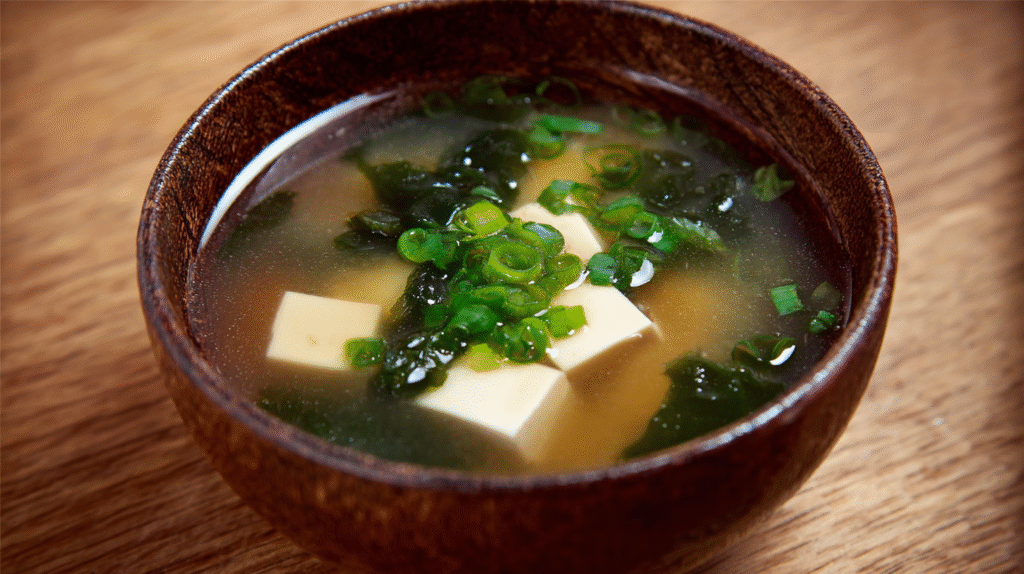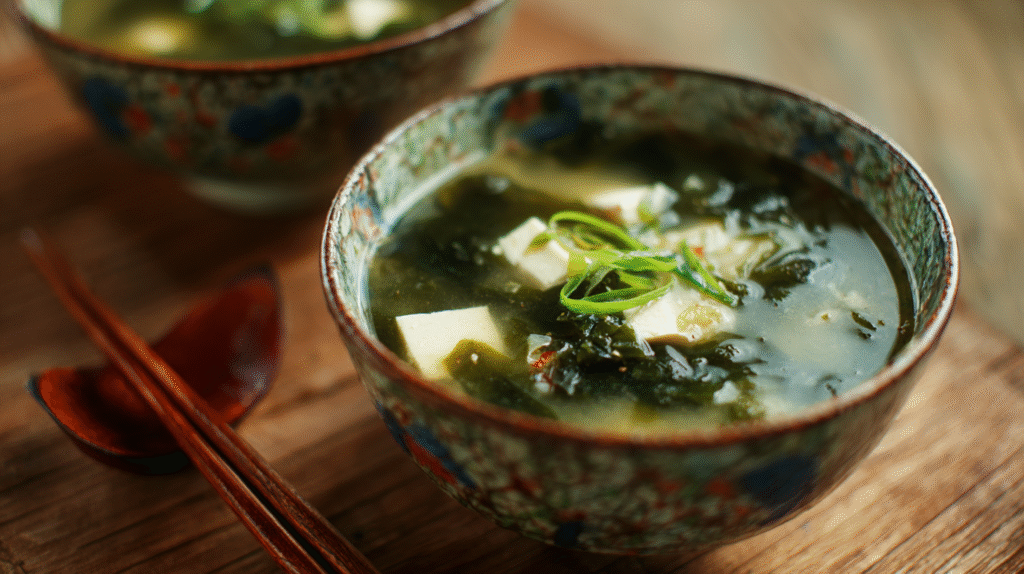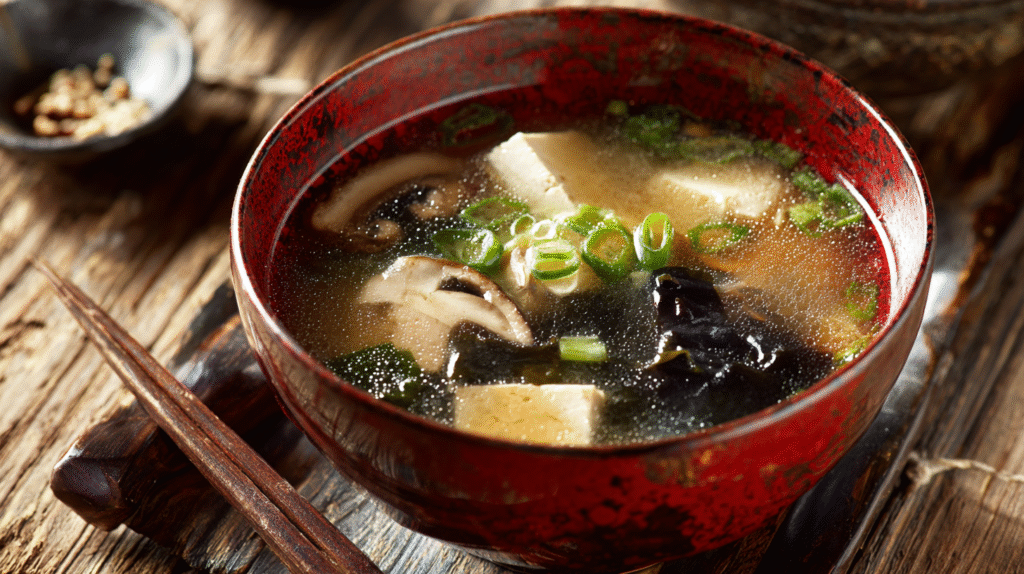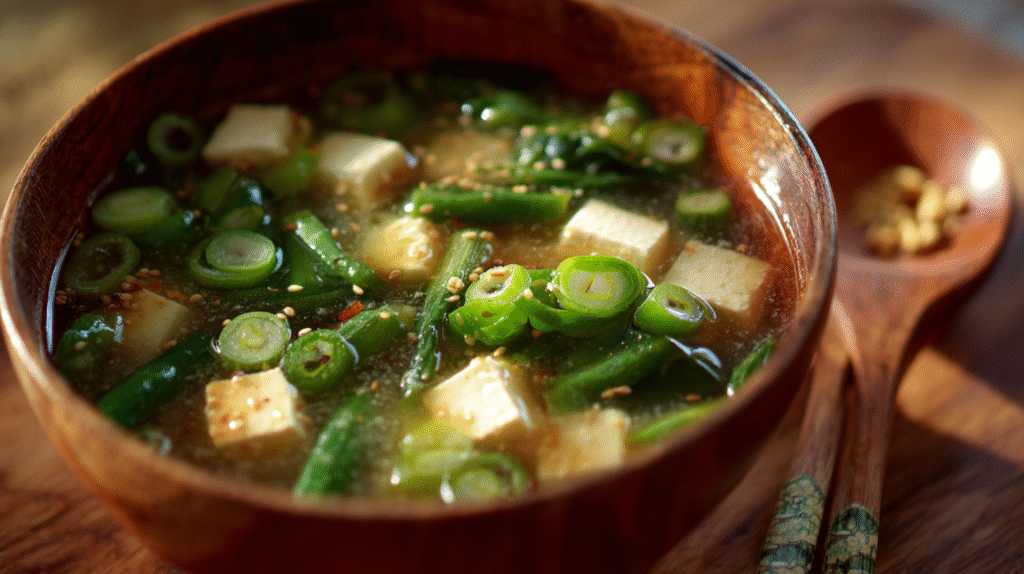What is Miso Soup?
Miso soup (味噌汁 or misoshiru) stands as one of Japan’s most fundamental culinary staples. This traditional Japanese dish consists of a flavorful dashi broth infused with miso paste and typically contains various ingredients like tofu, seaweed, and green onions.
The heart of miso soup lies in its two key components: dashi and miso paste. Dashi provides the umami-rich base made from kombu (dried kelp) and bonito flakes (dried fish flakes), creating a delicate yet complex foundation. Miso paste, a fermented soybean product, adds depth and that distinctive savory flavor that makes the soup so comforting.
You’ll find miso soup served daily in Japanese households as part of breakfast, lunch, or dinner. Many Japanese families consider this nourishing broth essential to their diet, often preparing it fresh for each meal. The soup’s significance extends beyond mere sustenance to represent Japanese culinary tradition and home cooking.
Various regions across Japan prepare miso soup differently, incorporating local ingredients and preferences. Northern regions might use heartier red miso in winter months, while southern areas often prefer lighter white miso varieties. Some versions feature seasonal vegetables, mushrooms, shellfish, or even meat depending on the region and occasion.
The beauty of miso soup lies in its simplicity and versatility. While maintaining its fundamental elements, you can easily adapt it to your taste preferences or dietary needs without compromising its authentic character. This adaptability has helped miso soup gain popularity worldwide as both a comfort food and a nutritious dietary addition.
Why You’ll Love This Miso Soup Recipe

This authentic miso soup recipe offers the perfect balance of simplicity and flavor that will quickly become a staple in your kitchen repertoire. Ready in just 15 minutes from start to finish you’ll appreciate how this nourishing bowl fits effortlessly into your busy schedule.
The umami depth from properly prepared dashi broth creates a foundation that store-bought versions simply cannot match. Your taste buds will immediately recognize the difference when savory miso paste melts into homemade broth creating layers of complex flavor.
Health benefits abound in every spoonful as this recipe delivers gut-friendly probiotics from fermented miso while providing a satisfying yet light meal option. The customizable nature allows you to adjust ingredients based on dietary preferences or what’s available in your pantry.
Budget-friendly cooking shines through as this recipe transforms inexpensive pantry staples into a restaurant-quality dish. Most ingredients keep well for months making this an economical choice for regular enjoyment.
Traditional Japanese techniques become accessible through the straightforward instructions that demystify what might otherwise seem like a complicated culinary process. You’ll master the essential skill of adding miso paste correctly to preserve its live cultures and maximum flavor.
Perfect for beginners yet satisfying for experienced cooks this versatile soup serves beautifully as a starter course or pairs with simple additions to create a complete meal. The authentic flavor profile transports you to Japan without requiring hard-to-find ingredients or specialized equipment.
Key Ingredients for Authentic Miso Soup

Creating authentic miso soup requires just a handful of essential Japanese ingredients that work together to develop its characteristic umami-rich flavor. Each component plays a vital role in achieving the perfect balance that makes this humble soup so satisfying.
Types of Miso Paste
Miso paste forms the foundation of your soup and comes in several varieties that differ in flavor intensity color and fermentation time. White miso (shiro miso) offers a mild sweet flavor with lower salt content making it perfect for beginners or those who prefer gentler flavors. Red miso (aka miso) delivers a robust earthy taste with deeper umami notes due to its longer fermentation period typically 1-3 years. Yellow miso (shinshu miso) sits between white and red varieties offering a balanced flavor profile that works well in most recipes. Many Japanese households keep multiple types on hand switching between them based on the season personal preference or accompanying dishes. For your first homemade miso soup yellow miso provides an excellent starting point with its versatile medium-bodied taste that complements most add-ins.
Dashi Stock Options
Dashi provides the crucial flavor base that distinguishes authentic miso soup from simple miso-flavored water. Traditional dashi combines kombu (dried kelp) and katsuobushi (dried bonito flakes) to create a broth brimming with natural umami. Awase dashi this classic combination delivers the most balanced flavor profile and represents the gold standard for miso soup. Kombu dashi made solely from dried kelp offers a vegetarian alternative with a lighter yet still complex taste. Shiitake dashi uses dried shiitake mushrooms to create a richly flavored vegan broth with earthy notes. Instant dashi granules provide a convenient option when time constraints exist though they typically contain more sodium and fewer nuanced flavors than homemade versions. For truly authentic results consider making awase dashi from scratch which requires just 15-20 minutes and significantly elevates your soup’s flavor complexity.
Traditional Add-ins
The beauty of miso soup lies in its customizability through various traditional ingredients that add texture nutrition and visual appeal. Tofu typically silken variety cut into small cubes absorbs the broth’s flavors while adding protein and a delicate texture. Wakame a type of seaweed that expands dramatically when rehydrated contributes minerals oceanic notes and a pleasant slippery texture. Green onions (scallions) thinly sliced and added just before serving provide a fresh aromatic finish and vibrant color contrast. Daikon radish thinly sliced or diced introduces a mild peppery crunch and aids digestion. Fresh mushrooms particularly enoki or shiitake add earthy depth and meaty texture making the soup more substantial. For regional variations consider adding clams in coastal areas potato in northern regions or seasonal vegetables based on availability. The traditional combination of tofu wakame and green onions creates a balanced soup with complementary textures and visual appeal that honors the classic preparation while remaining accessible to home cooks outside Japan.
Equipment Needed
Making miso soup requires minimal kitchen equipment which makes it an accessible dish for cooks of all levels. You’ll need:
- Medium saucepan – For heating the dashi and cooking the soup components
- Fine mesh strainer – Helpful when using traditional dashi ingredients to remove solids
- Small bowl – For mixing the miso paste with some broth before adding to the main pot
- Wooden spoon or whisk – To dissolve the miso paste properly without damaging it
- Measuring cups and spoons – For accurate ingredient proportions
- Sharp knife and cutting board – For preparing tofu, green onions, and any additional vegetables
Standard kitchen tools are sufficient for creating authentic miso soup at home. The most important aspect is using a non-metallic utensil like a wooden spoon when incorporating the miso paste, as metal can sometimes react with the fermented paste and alter its delicate flavor profile. Your soup will come together quickly with these basic tools that most kitchens already have on hand.
How to Make Miso Soup

Creating authentic miso soup requires just a few simple steps that build layers of traditional Japanese flavors. Follow this method to achieve a perfectly balanced soup with deep umami notes in under 15 minutes.
Preparing the Dashi
Start by making dashi broth, the foundation of your miso soup. Pour 4 cups of water into a medium saucepan and add a 4-inch piece of kombu seaweed. Heat the water on medium-low until small bubbles begin to form around the edges but do not let it boil. Remove the kombu just before boiling to prevent a bitter flavor. Add ½ cup bonito flakes to the hot water if using awase dashi. Turn off the heat and let the bonito steep for about 2 minutes until they sink to the bottom. Strain the broth through a fine-mesh strainer into another container. For vegetarian options, use just kombu or dried shiitake mushrooms instead of bonito. Your dashi should appear light golden and clear with a subtle oceanic aroma.
Adding the Miso Paste
Take 3-4 tablespoons of your preferred miso paste and place it in a small bowl. Ladle some hot dashi broth (about ¼ cup) into the bowl with the miso paste. Whisk gently with a wooden spoon or bamboo whisk until the paste fully dissolves with no lumps remaining. Never add miso directly to boiling broth as high heat destroys its probiotics and complex flavors. Return your dashi to low heat without boiling. Pour the dissolved miso mixture into the saucepan with the remaining dashi and stir gently to incorporate. Maintain the broth at a gentle simmer rather than a rolling boil to preserve the miso’s beneficial properties.
Incorporating Additional Ingredients
Add your chosen ingredients to the simmering broth-miso mixture in order of cooking time required. For firm tofu, cut it into ½-inch cubes and add it first, simmering for 2 minutes to absorb flavor. Rehydrate 2 tablespoons of dried wakame seaweed in a separate bowl of cold water for 5 minutes until expanded, then drain and add to the soup about 1 minute before serving. Thinly slice 2-3 green onions and reserve them for garnish. For mushrooms such as enoki or shiitake, slice them thinly and add them 2-3 minutes before finishing. Soft vegetables like spinach need only 30 seconds of heat before serving. Taste your soup and adjust with additional miso if needed for more flavor depth. Ladle the hot soup into individual bowls and top with sliced green onions just before serving for maximum freshness and visual appeal.
Tips for Perfect Miso Soup

Choose the Right Miso
Selecting the appropriate miso paste significantly impacts your soup’s flavor profile. White miso (shiro) offers a sweeter, milder taste perfect for beginners or lighter soups. Red miso (aka) delivers a more robust, saltier flavor that stands up well to heartier ingredients. Yellow miso (shinsu) provides a balanced middle ground between the two. Match your miso selection to your meal context—lighter varieties complement delicate dishes while stronger miso works well with rich meals.
Mind Your Temperature
Never boil miso paste as high heat destroys its beneficial probiotics and compromises its delicate flavor. Always remove your pot from heat before adding miso paste to the broth. Dissolve miso in a small amount of warm broth first then incorporate it back into the main pot. This technique ensures even distribution without exposing the paste to excessive heat that would diminish both nutritional value and taste complexity.
Balance Your Ingredients
Maintain proper proportions for authentic miso soup. Use approximately 1 tablespoon of miso paste per cup of dashi broth as a starting point. Adjust according to your taste preferences and the strength of your miso variety. Add just enough wakame seaweed—it expands significantly in liquid so a little goes a long way. Include tofu in bite-sized pieces that complement rather than overwhelm the broth. Garnish with a modest amount of green onions for a fresh accent without dominating the soup.
Make Fresh Dashi When Possible
Homemade dashi creates the foundation for exceptional miso soup. Though instant dashi granules offer convenience they cannot match the depth and nuance of fresh dashi. Set aside just 15 extra minutes to prepare authentic dashi from kombu and bonito flakes. The enhanced umami foundation dramatically elevates your miso soup’s overall quality. For vegetarian options try kombu-only or shiitake mushroom dashi which deliver impressive flavor without animal products.
Serve Immediately
Miso soup tastes best freshly made and served right away. The aromatic qualities diminish quickly as the soup sits. If you must prepare ahead keep the broth separate from the miso paste until just before serving. When reheating leftover soup gentle warming prevents boiling which would damage the soup’s flavor profile. Use a small pot over low heat and stir frequently to maintain the integrity of all ingredients especially the delicate miso paste.
Store Miso Properly
Preserve your miso paste correctly to maintain its quality for future use. Keep unused miso refrigerated in an airtight container with plastic wrap pressed directly onto its surface to prevent oxidation. Most miso varieties last 9-12 months when stored properly. White miso generally has a shorter shelf life than darker varieties due to its higher rice content. Always check for changes in color smell or texture before using stored miso.
Variations to Try
Traditional miso soup provides a perfect canvas for culinary creativity. These adaptations maintain the soul of authentic miso soup while introducing new flavors and textures to suit different preferences and dietary needs.
Vegetarian Miso Soup
Creating a fully vegetarian miso soup requires just a few simple adjustments to the traditional recipe. Start with kombu dashi or shiitake dashi instead of bonito-based broth for a plant-based foundation with equally impressive depth. Add extra umami by incorporating dried shiitake mushrooms soaked in water until soft then sliced thinly. You can enhance the nutritional profile with a variety of vegetables such as spinach carrots bok choy or snow peas that complement the delicate flavor of the broth. For protein consider adding extra firm tofu cubes or even edamame beans. White or yellow miso works beautifully in vegetarian versions offering a milder flavor that allows the vegetable ingredients to shine. Garnish with microgreens or a sprinkle of sesame seeds for added texture and visual appeal.
Seafood Miso Soup
Transform your basic miso soup into a seafood delight by incorporating ocean treasures. Small pieces of firm white fish like cod or sea bass work wonderfully when added during the final minutes of cooking. You might include cleaned shrimp or scallops for a protein-rich variation that needs just 2-3 minutes to cook through in the hot broth. Clams and mussels introduce a natural briny flavor that pairs perfectly with miso’s earthiness—simply add them to the hot broth and cook until they open. The combination of red miso with seafood creates a more robust flavor profile that stands up well to stronger oceanic tastes. Fresh ginger adds a warming note that complements seafood particularly well. Green onions and a touch of yuzu juice or lemon zest brighten this hearty variation making it suitable as a light main course.
Hearty Miso Soup with Tofu and Vegetables
For a more substantial meal transform your miso soup into a nourishing one-bowl wonder packed with protein and vegetables. Begin with extra-firm tofu cubes that hold their shape well in the broth alongside traditional soft tofu for textural contrast. Root vegetables like daikon radish sweet potatoes or turnips add satisfying heft and absorb the flavorful broth beautifully when simmered until tender. You can incorporate seasonal vegetables such as kabocha squash in fall or fresh corn in summer to create variations throughout the year. A handful of cooked soba or udon noodles turns this soup into a complete meal while maintaining its Japanese essence. This heartier version benefits from a mix of red and white miso for balanced flavor complexity. Finish with a drizzle of sesame oil and a sprinkle of shichimi togarashi (Japanese seven-spice blend) for added warmth and dimension.
Make-Ahead and Storage Instructions

Miso soup is best enjoyed fresh but can absolutely be prepared ahead of time with a few simple techniques. To make components ahead for quick assembly, prepare your dashi broth up to 3 days in advance and store it covered in the refrigerator. You can also pre-cut tofu and soak wakame separately keeping them refrigerated until needed.
For storing leftover miso soup, allow it to cool completely before transferring to an airtight container. Refrigerate for up to 2 days at most – the flavors will begin to deteriorate beyond this point. Never freeze miso soup as the delicate texture of tofu and seaweed will become unpleasantly mushy.
When reheating miso soup, gentle warming is essential. Pour the soup into a saucepan and heat on low just until warmed through (around 165°F). Avoid boiling as high heat destroys beneficial probiotics and can create a bitter taste. Fresh toppings like sliced green onions should be added only after reheating for the brightest flavor and appearance.
Remember that the miso paste itself will keep for months when stored properly in the refrigerator with the container tightly sealed. This allows you to make fresh batches of soup whenever the craving strikes without repeated shopping trips for specialty ingredients.
Serving Suggestions

Miso soup shines as both a standalone dish and a complementary addition to various meals. Serve it in traditional Japanese ceramic bowls to enhance the authentic experience and maintain proper temperature. These bowls typically hold about 8 ounces of soup which is the perfect serving size for this umami-rich broth.
Present your miso soup as a starter before main courses like sushi bento boxes teriyaki dishes or tempura. Many Japanese restaurants offer miso soup as the opening act to prepare your palate for the meal ahead. For breakfast pairings Japanese-style combine miso soup with steamed rice pickled vegetables and a small piece of grilled fish for a nutritionally balanced morning meal.
Transform your miso soup into a complete lunch by adding more substantial ingredients. Try incorporating udon or soba noodles for a heartier version that can stand alone as a satisfying midday meal. This approach works particularly well during colder months when you need something warming and substantial.
Create a dinner ensemble by serving miso soup alongside rice gyoza (dumplings) and a simple vegetable side dish. The soup balances heavier components of your meal with its light yet flavorful profile. For special occasions pair miso soup with more elaborate Japanese dishes like sukiyaki shabu-shabu or unagi (grilled eel) to create a multi-course experience.
Garnish your soup just before serving with additional thinly sliced green onions or a sprinkle of toasted sesame seeds for visual appeal and textural contrast. Consider providing small dishes of extra add-ins like thinly sliced mushrooms crispy fried tofu bits or fresh herbs allowing guests to customize their soup according to personal preferences.
Timing matters when serving miso soup. Present it hot but not scalding approximately 2-3 minutes after removing from heat to protect both the beneficial probiotics and your guests. The ideal serving temperature sits between 140-160°F (60-71°C) where the soup remains pleasantly warm without destroying its nutritional properties.
Nutritional Benefits of Miso Soup

Miso soup stands out as a nutritional powerhouse packed with essential nutrients even though its simple preparation. A standard serving (about 1 cup) contains only 40-70 calories while delivering impressive health benefits that make it an excellent addition to your regular diet.
Rich in Probiotics
The fermentation process used to create miso paste cultivates beneficial bacteria that support digestive health. These live probiotics help maintain a balanced gut microbiome which can improve digestion and strengthen your immune system. Unpasteurized miso contains Aspergillus oryzae and other beneficial microorganisms that aid in breaking down foods and absorbing nutrients more efficiently.
Source of Essential Proteins
Miso provides a complete protein profile containing all nine essential amino acids your body cannot produce on its own. The soybean base of miso delivers roughly 2-3 grams of protein per serving making it an excellent protein source especially for plant-based diets. When combined with tofu the protein content increases significantly providing sustained energy throughout your day.
Vitamin and Mineral Content
Miso soup offers an impressive array of vitamins and minerals essential for optimal body function:
- Vitamin K for bone health and blood clotting
- B vitamins including B12 which supports nerve function and energy production
- Zinc for immune function and wound healing
- Manganese for metabolism and bone development
- Copper for red blood cell formation
- Iron for oxygen transport throughout the body
The seaweed commonly added to miso soup contributes iodine which supports thyroid function and proper metabolism.
Antioxidant Properties
Miso contains powerful antioxidants that help neutralize free radicals in your body. These compounds may reduce oxidative stress and inflammation that contribute to chronic diseases. The isoflavones found in miso have been studied for their potential to reduce heart disease risk and support hormonal balance.
Nutritional Profile
| Nutrient | Amount per 1 cup serving |
|---|---|
| Calories | 40-70 calories |
| Protein | 2-3g |
| Sodium | 600-900mg |
| Vitamin K | 10-15% DV |
| Manganese | 12-15% DV |
| Copper | 6-9% DV |
| Zinc | 5-8% DV |
| Iron | 5-6% DV |
Low in Calories High in Satisfaction
Miso soup creates a feeling of fullness while being remarkably low in calories. The umami flavor satisfies your taste buds while the warm broth expands in your stomach creating satiety with minimal caloric intake. This makes miso soup an excellent choice for weight management when incorporated as part of balanced meals.
Considerations for Sodium Intake
While nutritionally beneficial miso soup contains important sodium due to the fermentation process. One cup typically provides 600-900mg of sodium approximately 25-40% of the recommended daily intake. If you monitor your sodium consumption consider using reduced-sodium miso varieties or diluting your soup with additional water without compromising flavor.
The Perfect Miso Soup Recipe

This traditional Japanese miso soup recipe delivers authentic flavor with minimal effort. Ready in just 15 minutes this comforting bowl balances savory umami notes with delicate ingredients for a truly satisfying experience.
Ingredients
For the Dashi Broth:
- 4 cups water
- 1 piece kombu (dried kelp) about 4×6 inches
- 1/2 cup bonito flakes (katsuobushi)
- OR 1 tablespoon instant dashi granules for quicker preparation
For the Miso Soup:
- 3-4 tablespoons miso paste (white preferred for milder flavor red for stronger)
- 8 oz silken or medium-firm tofu cubed
- 2 tablespoons dried wakame seaweed
- 2-3 green onions thinly sliced
- Optional additions: sliced mushrooms thinly sliced carrots or daikon radish
Preparation Steps
- Make the Dashi Broth: Place the kombu in a medium saucepan with cold water. Heat gradually over medium-low heat until small bubbles form around the edges (about 10 minutes). Remove the kombu just before the water boils to prevent bitterness.
- Add Bonito Flakes: Bring the water to a full boil then add bonito flakes. Turn off the heat immediately and let steep for 5 minutes while the flakes sink to the bottom.
- Strain the Broth: Pour the broth through a fine-mesh strainer into another pot or bowl. Discard the solids. Your dashi is now ready to use.
- Rehydrate Wakame: Place dried wakame in a small bowl with cold water for 5 minutes until rehydrated. Drain well and set aside.
- Dissolve Miso Paste: Return the strained dashi to medium-low heat. Take about 1/2 cup of the warm broth and place it in a small bowl. Add miso paste to this bowl and whisk with a wooden spoon until fully dissolved with no lumps.
- Combine Everything: Pour the dissolved miso mixture back into the pot with the remaining dashi. Stir gently to incorporate. Remember never to boil the soup after adding miso as high heat destroys beneficial probiotics and alters the flavor.
- Add Remaining Ingredients: Add the cubed tofu and rehydrated wakame to the soup. Simmer gently for 1-2 minutes until everything is heated through.
- Garnish and Serve: Ladle the hot soup into traditional Japanese bowls. Sprinkle freshly sliced green onions on top just before serving.
Cooking Tips for Perfect Results
The temperature matters significantly when making miso soup. Keep the broth below boiling point (around 180°F/82°C) after adding miso paste to preserve its live cultures and delicate flavor.
Use white miso (shiro miso) for your first attempt as its mild sweet profile is more approachable for beginners. Red miso (aka miso) creates a heartier soup with deeper flavor that works well during colder months.
Always dissolve miso paste in a separate bowl rather than adding it directly to the hot pot. This technique ensures proper integration without lumps and prevents the paste from clinging to the bottom of the pot.
Let the flavors meld for 1-2 minutes after combining all ingredients but serve promptly for optimal taste and texture. The soup begins to lose its nuanced flavors if left sitting too long.
For restaurant-quality presentation balance the solid ingredients evenly between serving bowls before pouring in the broth. This ensures each guest receives an equal distribution of tofu wakame and garnishes.
With these straightforward instructions you’ll create an authentic miso soup that rivals what you’d find in Japanese restaurants while enjoying the satisfaction of mastering this fundamental dish at home.
Conclusion
Now you’re ready to bring the comforting warmth of authentic Japanese cuisine into your own kitchen. This miso soup recipe offers more than just delicious flavors – it’s a gateway to centuries of culinary tradition that you can recreate in minutes.
Whether served as a simple breakfast starter or enhanced with heartier ingredients for dinner you’ll find miso soup adapts beautifully to your needs while delivering impressive nutritional benefits.
Don’t be surprised if this becomes your go-to comfort food. With just a few ingredients and basic equipment you can transport your taste buds to Japan whenever the craving strikes. Master this foundational recipe and you’ll have unlocked one of Japanese cuisine’s most beloved treasures.

